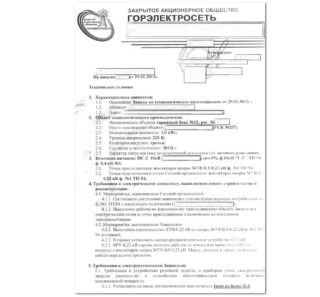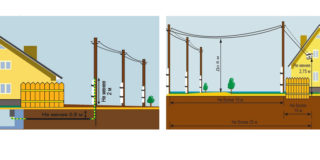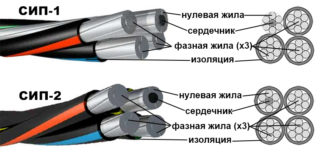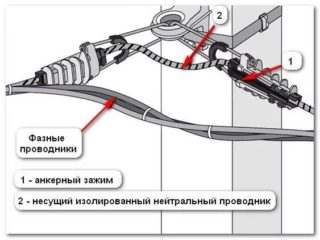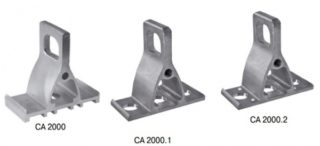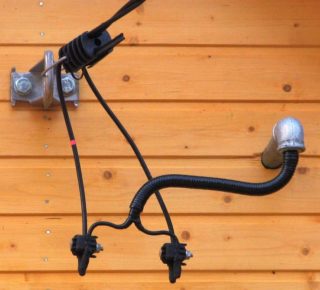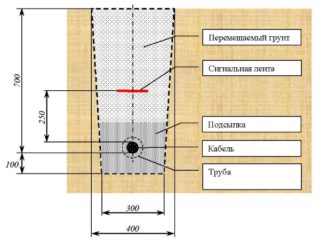The proper organization of the power supply of the living room provides for the calculation and installation of the entry point. To ensure the safety of the line and the durability of its operation, the rules of the PUE should be observed. Entering electricity into the house can begin after documentation and coordination of events with the energy provider.
Administrative Legal Nuances

In order to introduce electricity into the premises, the owner must obtain permits from the power supply. The basis for the permit is the PVE project, which describes in detail the internal electrical network, provides calculations of the capacity of consumers. After that, the parameters of the allocated power and the consumer limit are set. According to the PVE, technical conditions are determined - the connection method, communication features, engineering aspects.
Connect the house to electricity can RES teams, the owner or contractor with a license.
Required documents
The property owner sends a request to the selected network organization. The company considers the application within 15 days. After a positive response, the following documents are prepared:
- application for technical connection in a unified form;
- power receiver circuit;
- copies of documents on the right to a building or land allotment;
- application, which indicates the name of the citizen, passport data, location of the receivers, the timing of the project and the commissioning of the line, the name of the provider, permission for construction work.
After reviewing the documents, the energy provider sends an agreement with the technical conditions. The applicant is left to sign it and send it to the representatives of the network organization.
If the site meets the requirements of technical conditions, work on its territory is carried out at the expense of the owner. Events outside the allotment are paid by the network company. At the end of the implementation, the energy sales company connects the premises to the network after a control inspection.
Rules for connecting electricity to the house
The input power supply device is subject to the requirements of the PUE and technical conditions. They indicate:
- location of connection points - 25 m from the border with neighbors;
- the distance of the cable from the power transmission line supports to the wall is 10 cm if there is a wooden house and 5 cm from brick surfaces;
- cable thickness for a single-phase line - 0.6 cm for copper conductors, 1.6 cm for aluminum conductors;
- the need to close the introductory strobes with non-combustible material;
- location of the inlet - 2.75 m from the soil line and 1.5 m from the window;
- compliance with the equipment power of the allocated power of 15 kW;
- the distance in a straight line from the power grid to which the site adjoins is 300 m for the city and 500 m for the village.
Mandatory elements of the system are SIP-wires, electric meter, shield, intermediate metal support.
Correct Connection Options
Entering electricity into a private house can be done in two ways:
- Air is an inexpensive but notable option. The main part of the cable stretches on the street above the ground. The conductor can pass into the room in the pipe through the wall on the switchgear or counters. It is allowed to connect outside the house to a voltage stabilizer or accounting device;
- Underground is a hidden method when a wire is laid in an asbestos-cement pipe buried in the ground. Entrance to the building is through a technological hole in the foundation. From the power line to the input point, the cable is laid along the column.
Use heavy-duty wires for underground installation.
Choosing a cable to enter the house
An optimal material for a home electrical network is a SIP cable, which can be used to organize lines with a voltage of up to 35 kW. The wire consists of 3 phase conductors entwined with zero, has a high-quality insulating coating of polyethylene. The zero conductor of aluminum is located in the center of the twist.
If a SIP cable is needed for wiring from a pillar to a house through the air, you should pay attention to the insulation layer:
- thermoplastic insulation polyethylene SIP-1, SIP-1A, SIP-4 and SIPn-4 withstands temperatures up to +70 degrees;
- cross-linked polyethylene of materials SIP-2, SIP-2A, SIPs-4, SIP-3, PEV and PEVG withstands temperature loads up to 90 degrees, provides protection against overloads and short circuits.
A good cable for laying in the ground has an insulating surface made of pressed paper with impregnation, polyethylene, PVC. Veins VBBSHV or PvBShv reinforced with tape insulation. For areas with risk of damage, PaKShp with wire mesh is used.
Specifics of using SIP
You can bring the SIP cable on a support or facade, performing branches and other connections. When working with a wire, you must:
- pre-install the VLI supports by attaching the clamps to them;
- make rolling by installing rollers using a special belt or hooks. The wire is pulled to the extreme supports by a drum. Manually work as a cable leader;
- fasten the electrical conductor to the supports. The core is fixed with an anchor clip;
- tension the cable using a manual winch with a gripping amplifier;
- select for a single-phase network a 2-core SIP-4, for a three-phase network - a 4-core SIP-4.
You need to stretch it smoothly, without distortions until the torque wrench head breaks.
Armature for fastening SIP-wire
Fittings for self-supporting insulated wires ensure the correct and high-quality process of electricity transmission through the air. Designs should be made of moisture resistant materials, suitable for voltage of a single-phase or three-phase network. Replacement of products is allowed 1 time in 20 years.
Material List
In electrical practice, the following types of fittings are used:
- Anchor brackets - 1 per house and power line support. Aluminum devices are not subject to corrosion, temperature fluctuations. They are fixed with stainless steel banding tapes.
- branch clamps - 4 (220 V) or 8 (380 V) pieces. Create a contact when connecting cables with a cross section of 6-150 mm2 with conductors with a cross section of 1.5-6 mm2.
- Anchor clamps - 2 pcs. Elements provide fixing of wires with insulation on branches up to 1000 V. Internal wedges from thermoplastic exclude damage to the insulating layer;
- intermediate clamps. With their help, it is possible to connect SIP-4 to an intermediate or angular support. The material has a UV resistant casing.
- Hooks. They are used to conduct a conductor through the air on a wooden, metal support or wall surface.
You will also need a sleeve, a corrugated sleeve made of metal for supplying cables through the wall of the building.
Calculation of the cable cross section for entering the house
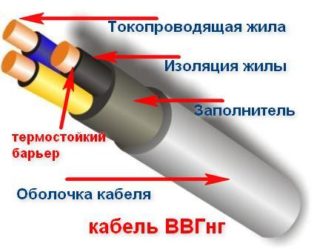 An SIP 2x16 or 4x16 cable is mounted on the street, inside the building - VVGng-ls 2x6, 2x10, 4x6, 4x10. The selection of the cross section for the input cable going to the private house is carried out depending on the load of consumers, the square of the rooms, outbuildings, the presence of electric heating and electric stove.
An SIP 2x16 or 4x16 cable is mounted on the street, inside the building - VVGng-ls 2x6, 2x10, 4x6, 4x10. The selection of the cross section for the input cable going to the private house is carried out depending on the load of consumers, the square of the rooms, outbuildings, the presence of electric heating and electric stove.
PUEs establish the use of copper cable for networking. The standard also notes the dependence of the cross section on line voltage and power parameters.In order not to engage in calculations, it is worth referring to the table.
| Current of machines, A | power, kWt | Cable section, mm2 | |
| 220 V network | 380 V network | ||
| 5 | 1,1 | 2,6 | 1 |
| 6 | 1,3 | 3,2 | 1 |
| 10 | 2,2 | 5,3 | 1,5 |
| 16 | 3,5 | 8,4 | 1,5 |
| 20 | 4,4 | 10,5 | 2,5 |
| 25 | 5,5 | 13,2 | 4 |
| 32 | 7 | 16,8 | 6 |
| 40 | 8,8 | 21,1 | 10 |
| 50 | 11 | 26,3 | 10 |
| 63 | 13,9 | 33,2 | 16 |
A suitable cable cross section for entering the house is from 6 to 16 mm2. A cable with a cross section of 6 mm2 is relevant from the meter to the bus of the single-phase network switchgear.
On the street, an aluminum cable with a cross section of 10 mm2 is used, which is not oxidized. For laying in a wooden house, a copper one that does not burn is advisable.
How is electricity introduced into a house by air
There are two ways to enter an electric line into a residential building by air:
- Through the walls. The conductor is located on the wall, fixed on it with insulated fasteners. For laying inside, an opening is organized through which a metal pipe with a plastic corrugation passes. The gap is sealed with cement or asbestos.
- Through the lid. A metal pipe is used. The conductor is placed so that the distance from the roof level is more than 2 m. The structure is earthed.
When laying through the roof, the pipe bends down, or a gander, in which wires for electricity are attached with ceramic insulators. In order to reduce cable lengths, wiring is performed as close as possible to the switchboard.
Air technology is simple, therefore popular among home craftsmen. The disadvantage of this method is the risk of damage to the wires during mechanical stress.
Features of laying the cable underground
The supply of electricity to a private house underground is carried out in a metal pipe. The length of the product corresponds to the length of the route, taking into account the rotation. The underground method involves the use of copper conductors with a cross section of 4 mm2, if the line is 10 m away. When removing more than 10 m, a 6 mm2 cable is used. The cross-section of an aluminum wire for a distance of up to 10 m is 12 mm2, from 10 m - 10-18 mm2.
Work on the introduction of electricity into a suburban or private house underground is carried out step by step:
- Digging a channel. Deep should not be done - 60-90 cm is enough. The width of the trench is 40 cm.
- A sand cushion is organized with a layer of 15 to 20 cm. To strengthen it and prevent material from falling through, a foundation can be made of brick or concrete slabs.
- On plastic soils or in areas where there is a high level of groundwater, additional protection is organized. A drainage tray is made of bricks or concrete blocks, which is covered with plates from above.
- On unstable soils, a monolithic reinforced concrete channel for the cable is made. It is covered with plates with reinforcing reinforcement.
- The steel pipe is cleaned of debris and laid in the finished channel.
- The elements of the pipe are connected with a slight overlap on each other.
- The wire extends through a metal pipe. For bending points, the rule applies - a larger radius that preserves the integrity of the insulation.
- After laying, the eyeliner is covered with dense bulk material - crushed stone, fragments of brick or large expanded clay.
- On top of the bulk materials, a sand cushion is made to protect the vehicles from breaking by passing vehicles.
- The channel is buried with excavated soil.
The organization of the electricity line underground from power lines to a private house takes more time and costs more. But in comparison with air equipment, the eyeliner will be durable and reliable.
Ways to organize wiring inside the house
There are several options for performing internal wiring.
Connect different cables inside
The SIP conductor is broken and connected to the VVGng cable by twisting and amplifying by soldering. The technique is not reliable, because it can lead to fires.
Connection of various conductors with reinforcement
Coupling SIP and VVGNG is carried out using standard reinforcing rods, clamps for piercing or other elements near the entry point.It is unacceptable to use SIP in a living room - it supports combustion processes.
Through difavtomat
The connection scheme provides for the use of a two- or four-pole differential circuit breaker. The device is located in a separate sealed box. The cable is laid from the main line to the box, connected to VVGng in the corrugation.
To increase protection, an automatic machine with a rating above the distribution board is used. So with a circuit or overload, you can restore the line without leaving the house. Outside, another device is installed that de-energizes the internal cable and prevents fire.
Electric lines can be introduced into a residential building by air or underground. Before starting work, it is necessary to draw up permits, select a SIP cable and its cross section.
